

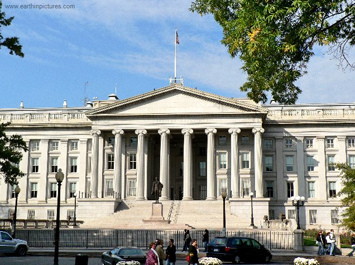

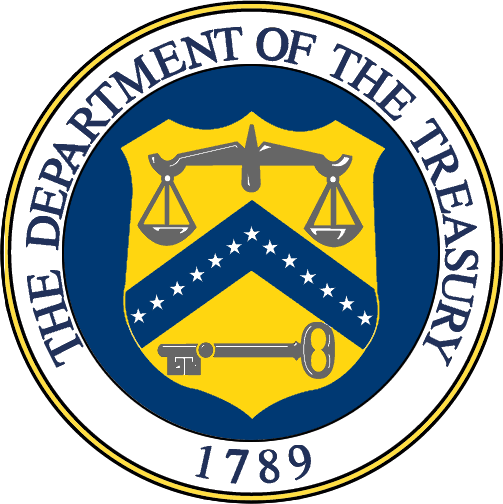
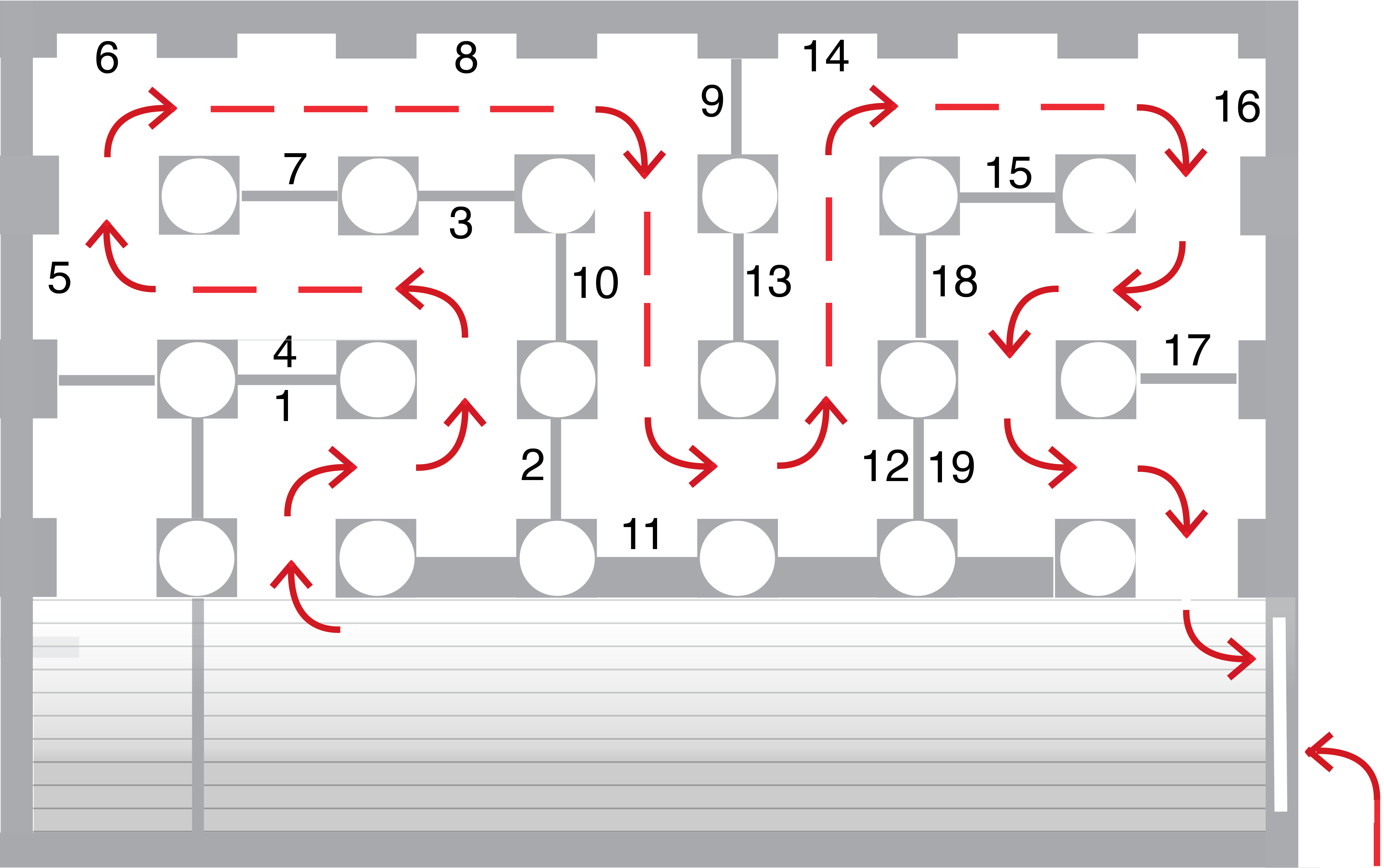


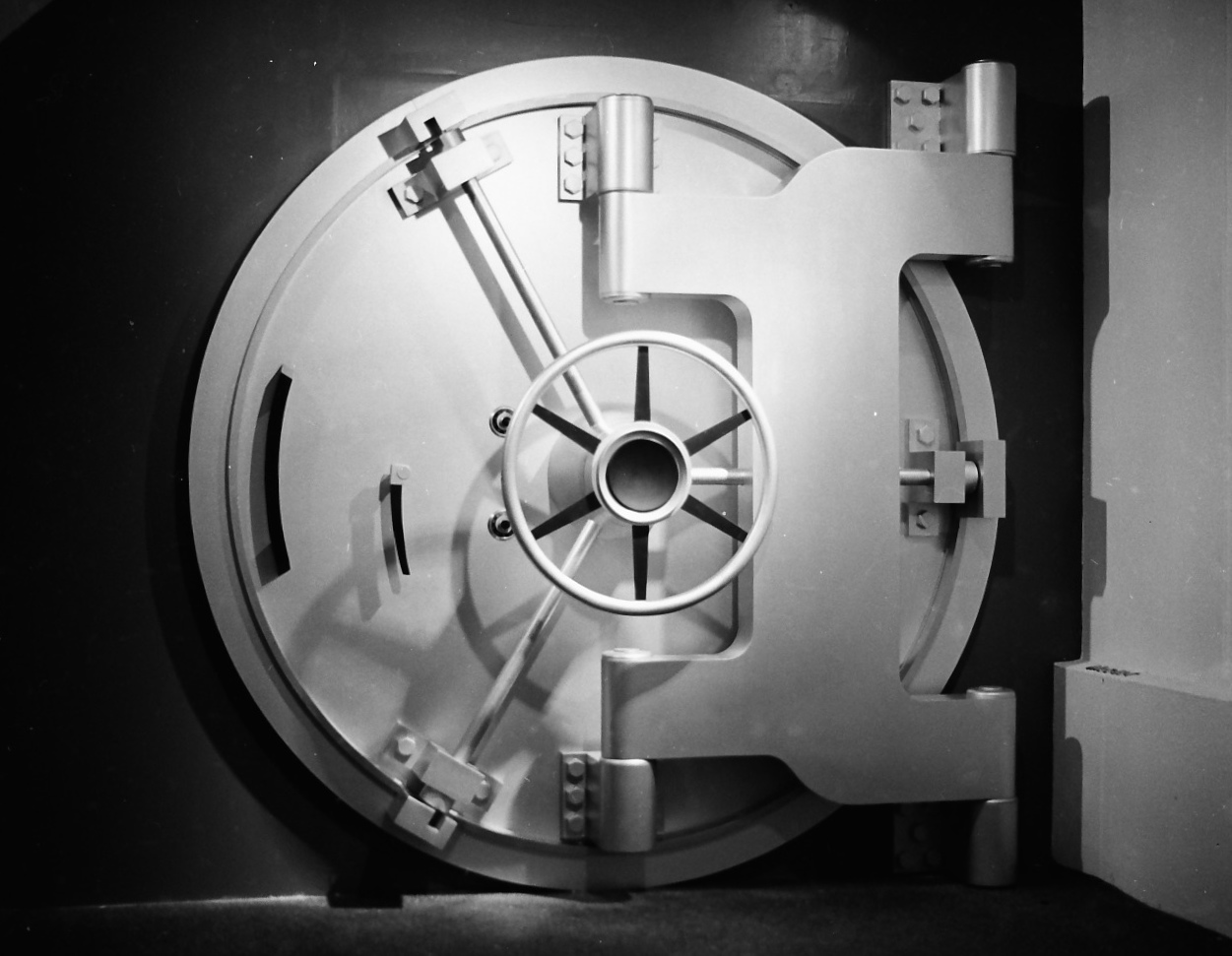
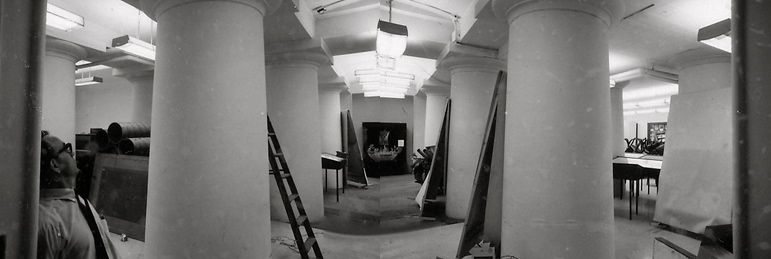
The U S Treasury Department selected George Nelson & Co.
to design an exhibition tracing the origins, growth and history
of the Department.
The exhibit concept was to
tell the story by moving visitors thru limited space with a programmed series of sequential displays. No captions or text would be necessary.
Upon entry, light and sound plus narration would draw a group of 8 to 12 visitors to the first display. Light and sound would fade at the end of the narration and come up on the next display, thus visually and aurally attracting the visitor to the next display. Each display cycle would last 2 to 3 minutes.
The hardware would include 35mm projectors, reel to reel audio tape and a complex series of cams, switches and relays controlling the programed light and sound.
to design an exhibition tracing the origins, growth and history
of the Department.
The exhibit concept was to
tell the story by moving visitors thru limited space with a programmed series of sequential displays. No captions or text would be necessary.
Upon entry, light and sound plus narration would draw a group of 8 to 12 visitors to the first display. Light and sound would fade at the end of the narration and come up on the next display, thus visually and aurally attracting the visitor to the next display. Each display cycle would last 2 to 3 minutes.
The hardware would include 35mm projectors, reel to reel audio tape and a complex series of cams, switches and relays controlling the programed light and sound.
The street level entry to the exhibit was to the right of the
eight columned portico of the 14th. Street entrance.
eight columned portico of the 14th. Street entrance.
The design challenge was to work within the restricted space
designated for the exhibit. The storage space below the building’s
14th St. entrance contained a vaulted area and a room with a
number of closely spaced columns. It led to a “maze” like solution.
designated for the exhibit. The storage space below the building’s
14th St. entrance contained a vaulted area and a room with a
number of closely spaced columns. It led to a “maze” like solution.
The vaulted entry area was used for a prologue to the exhibit and
waiting visitors.
waiting visitors.
The exhibit space had 18 closely spaced columns supporting the 14th. St. entry.

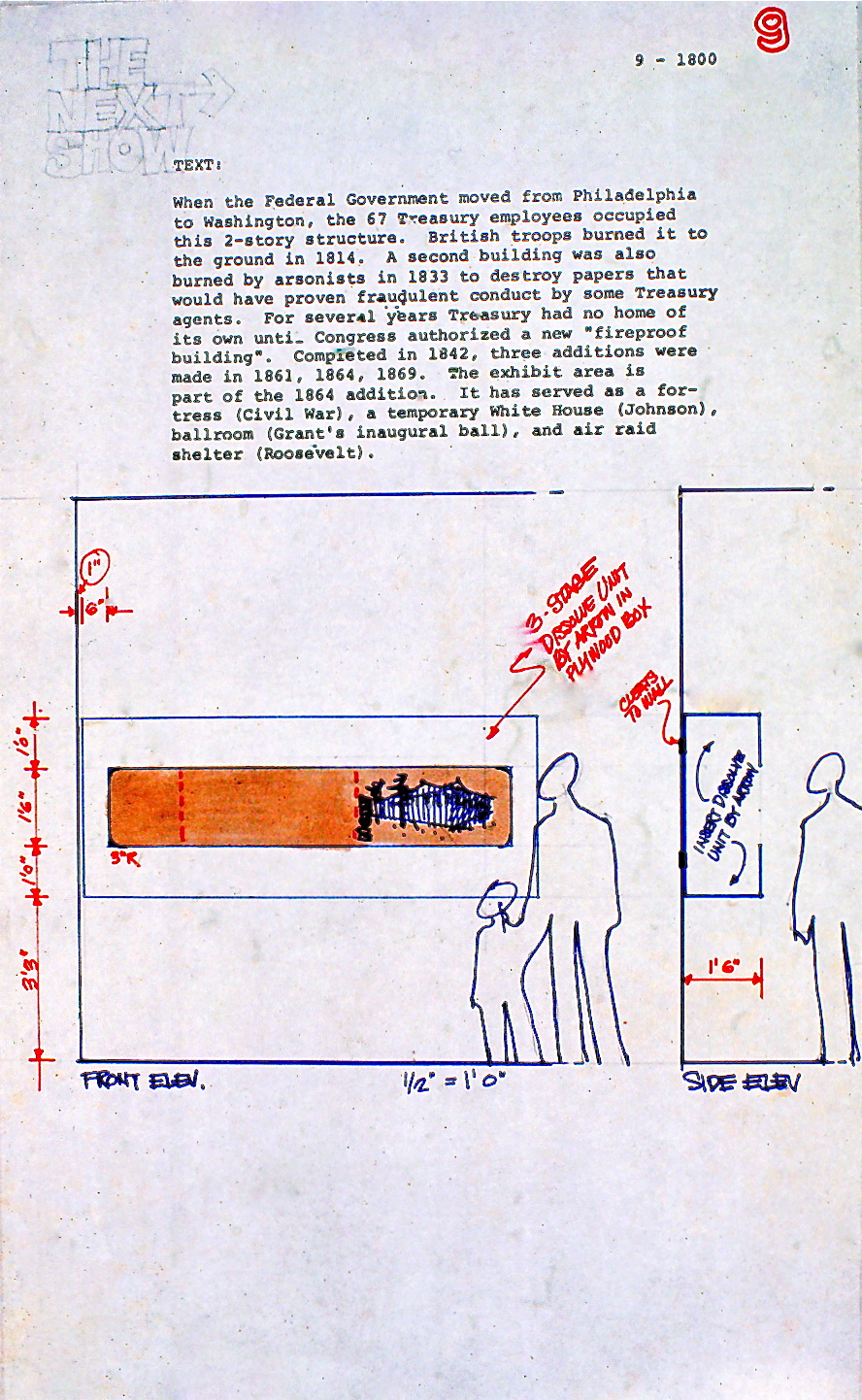
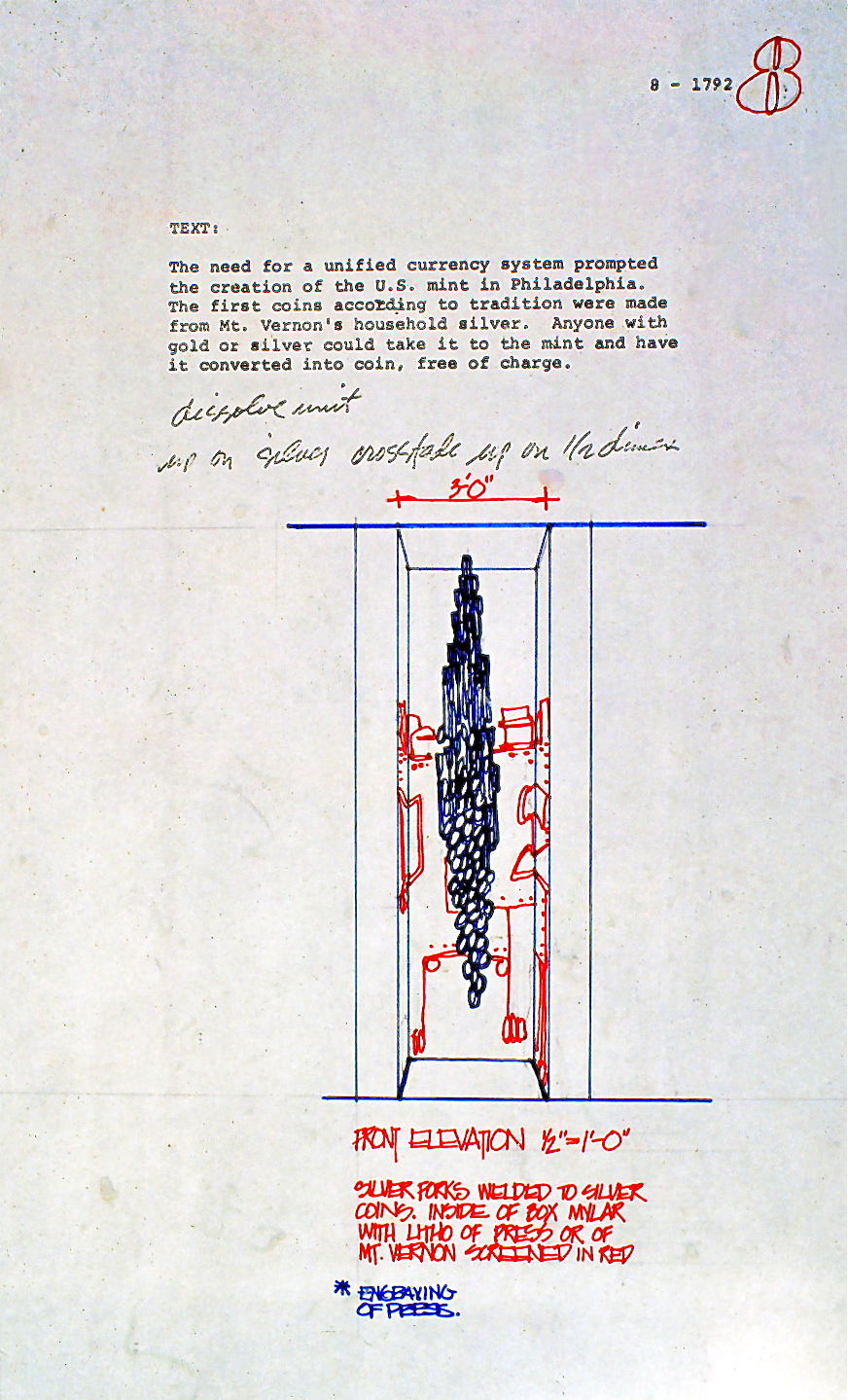

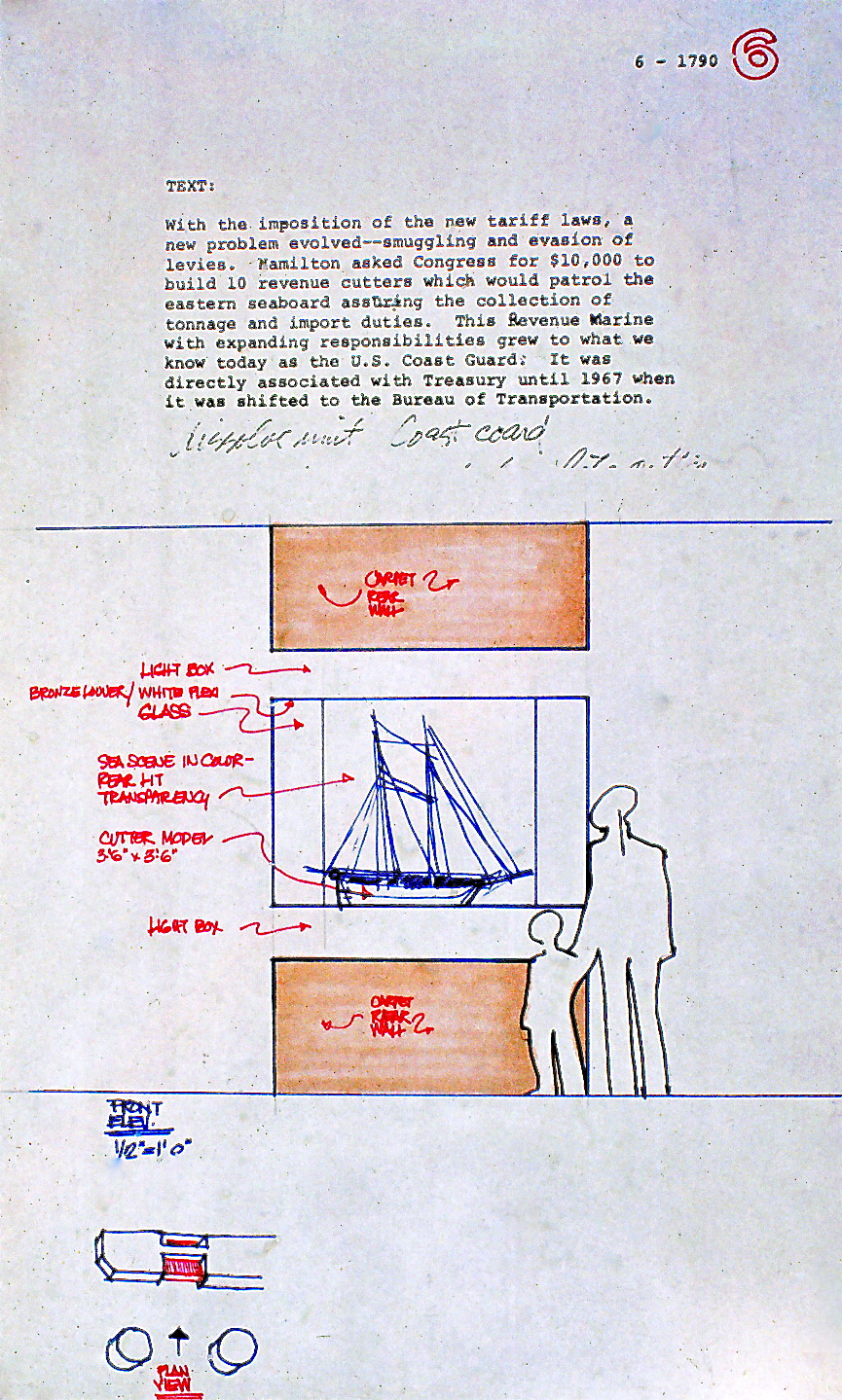


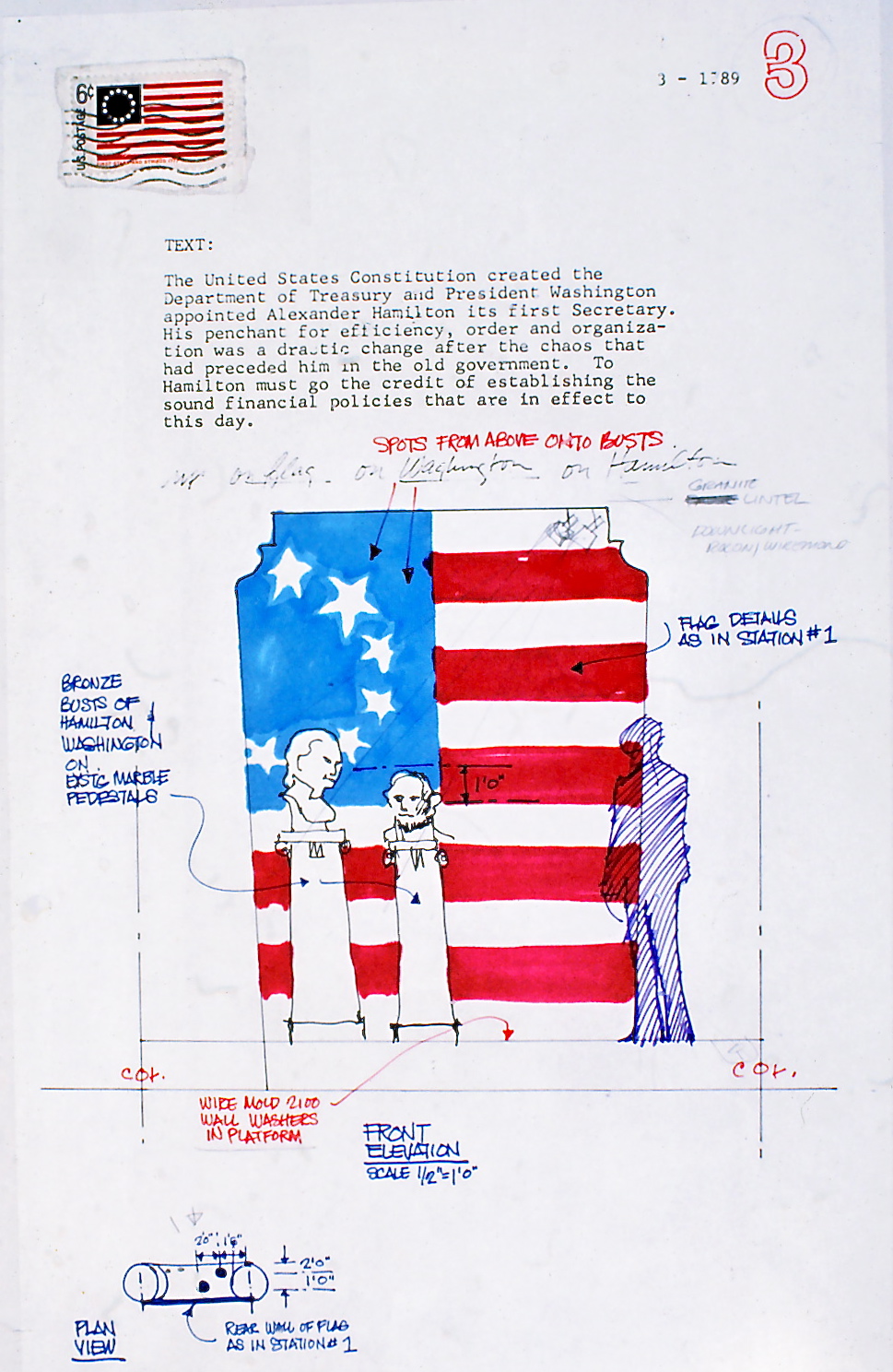


CONCEPT DEVELOPMENT

The design concept evolved into a series of sketches suggesting a programed sequence of exhibit events, including narration, that would tell and illustrate the chronological history and evolving development of the US Treasury Department.

Click on sketches to see all

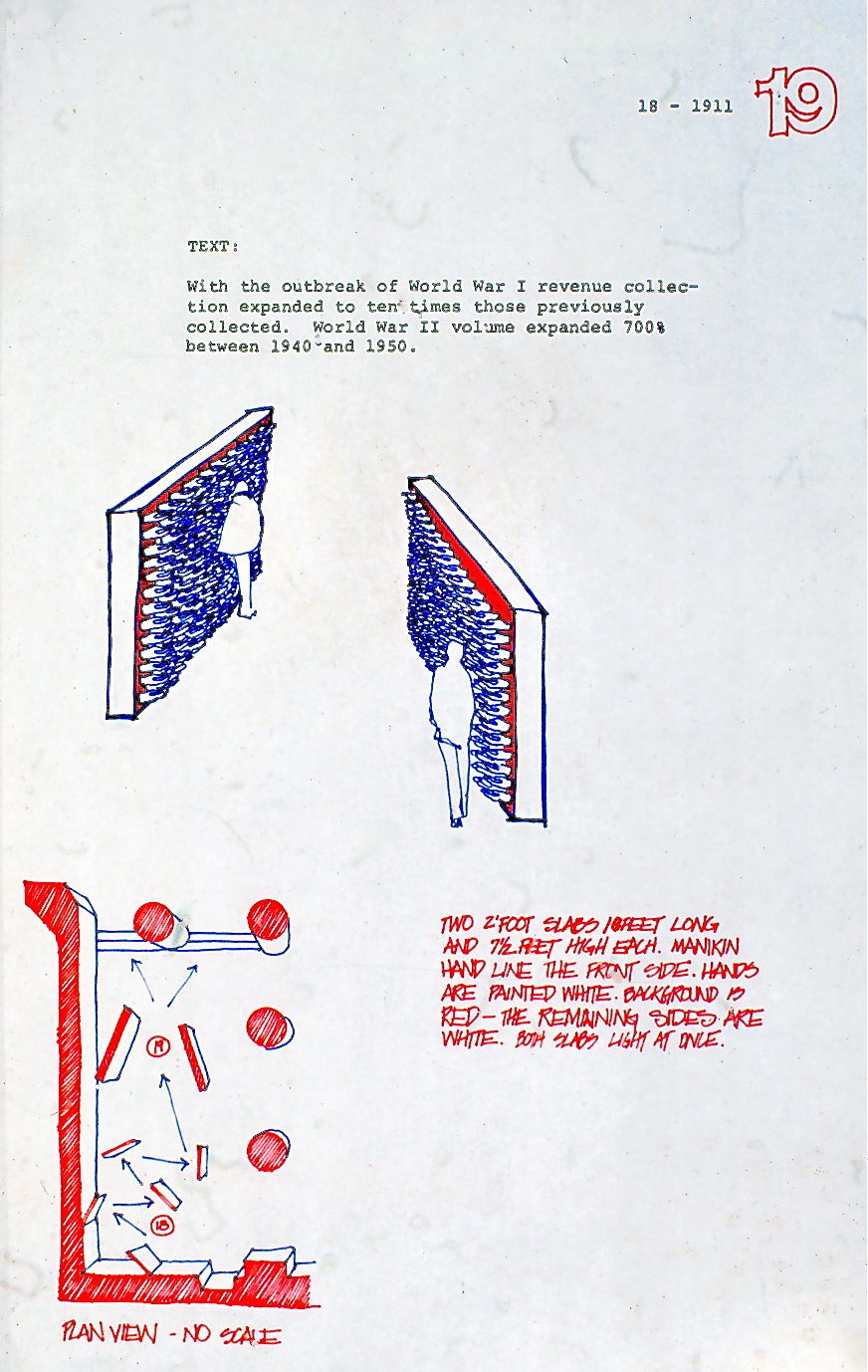
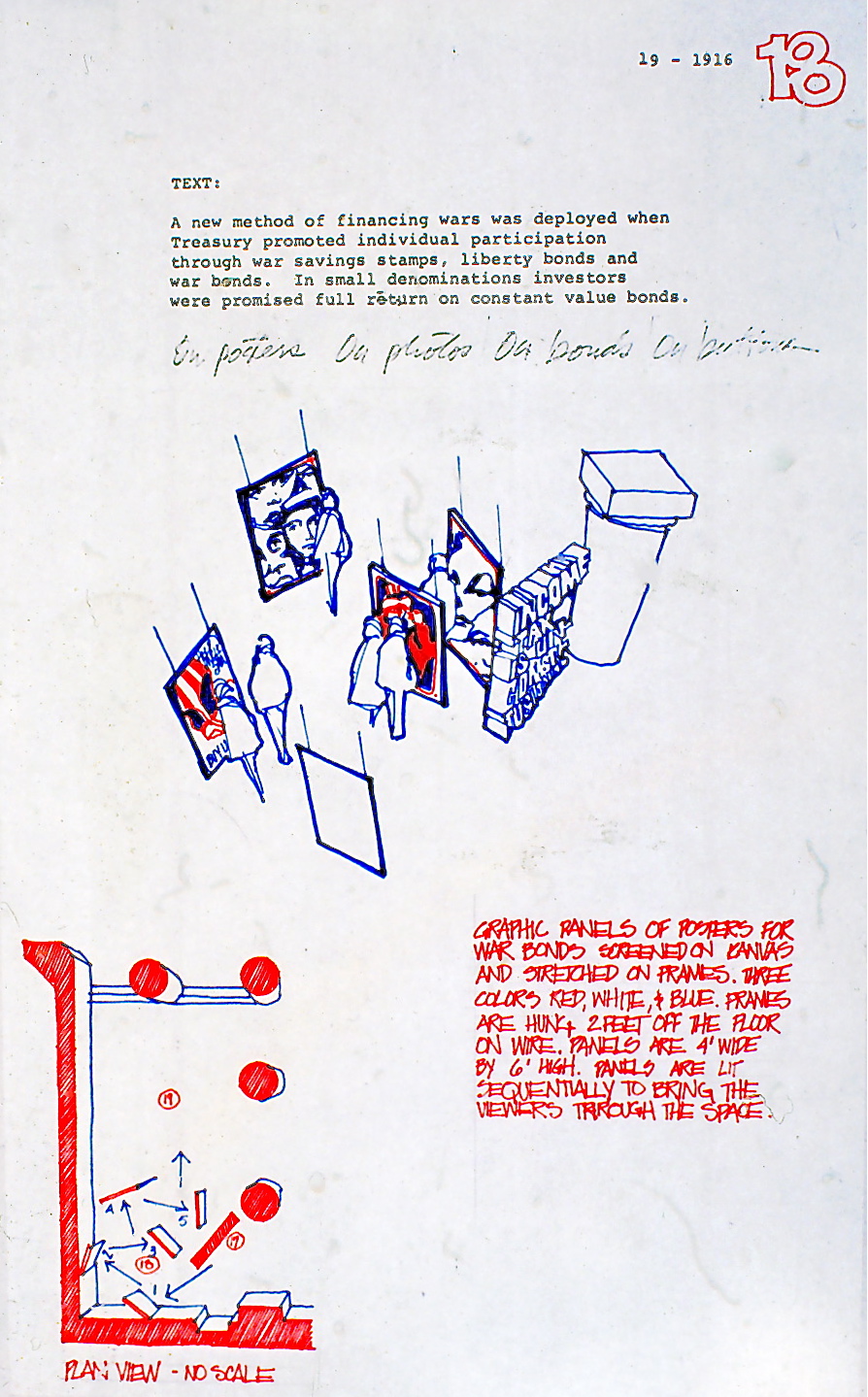

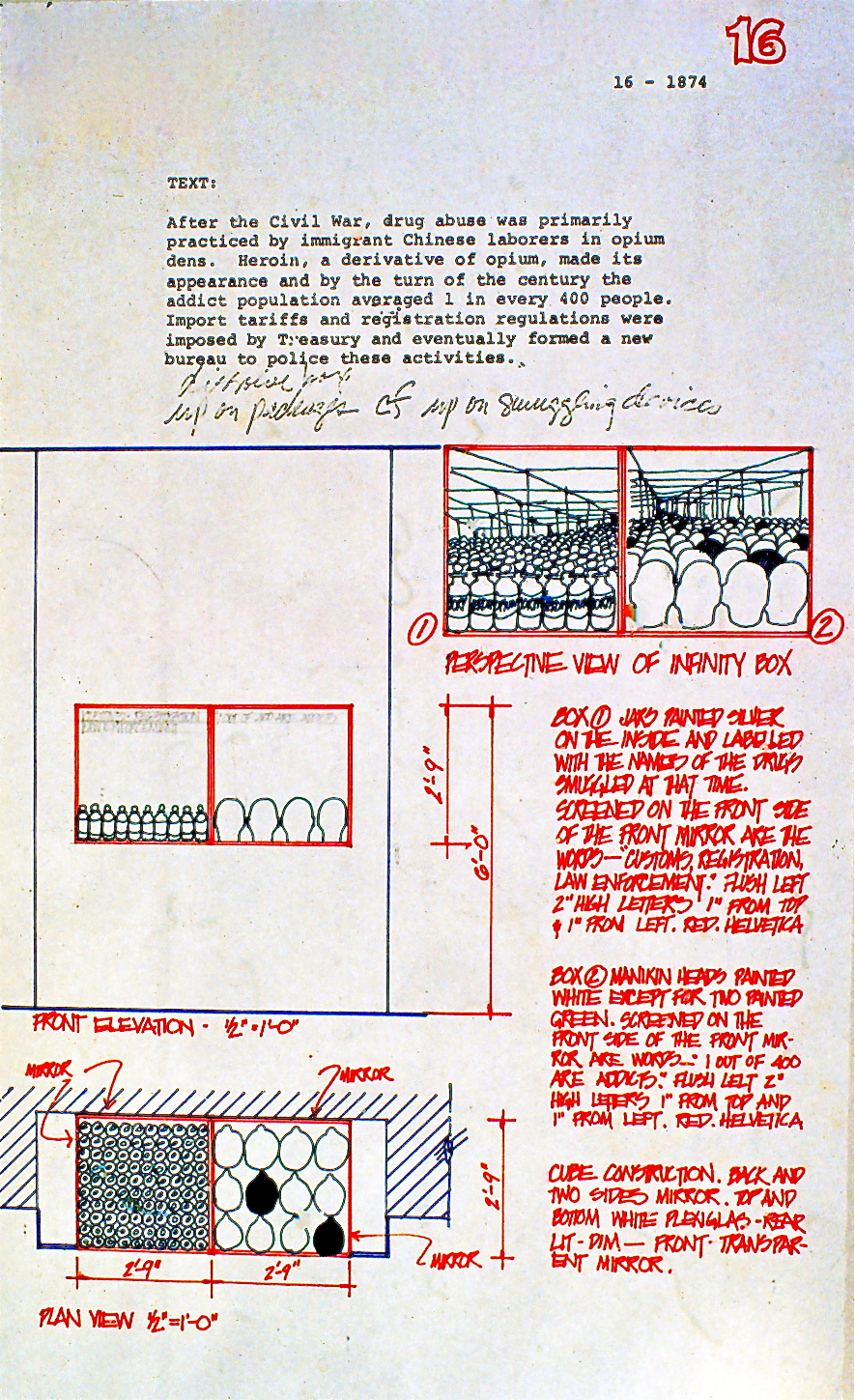
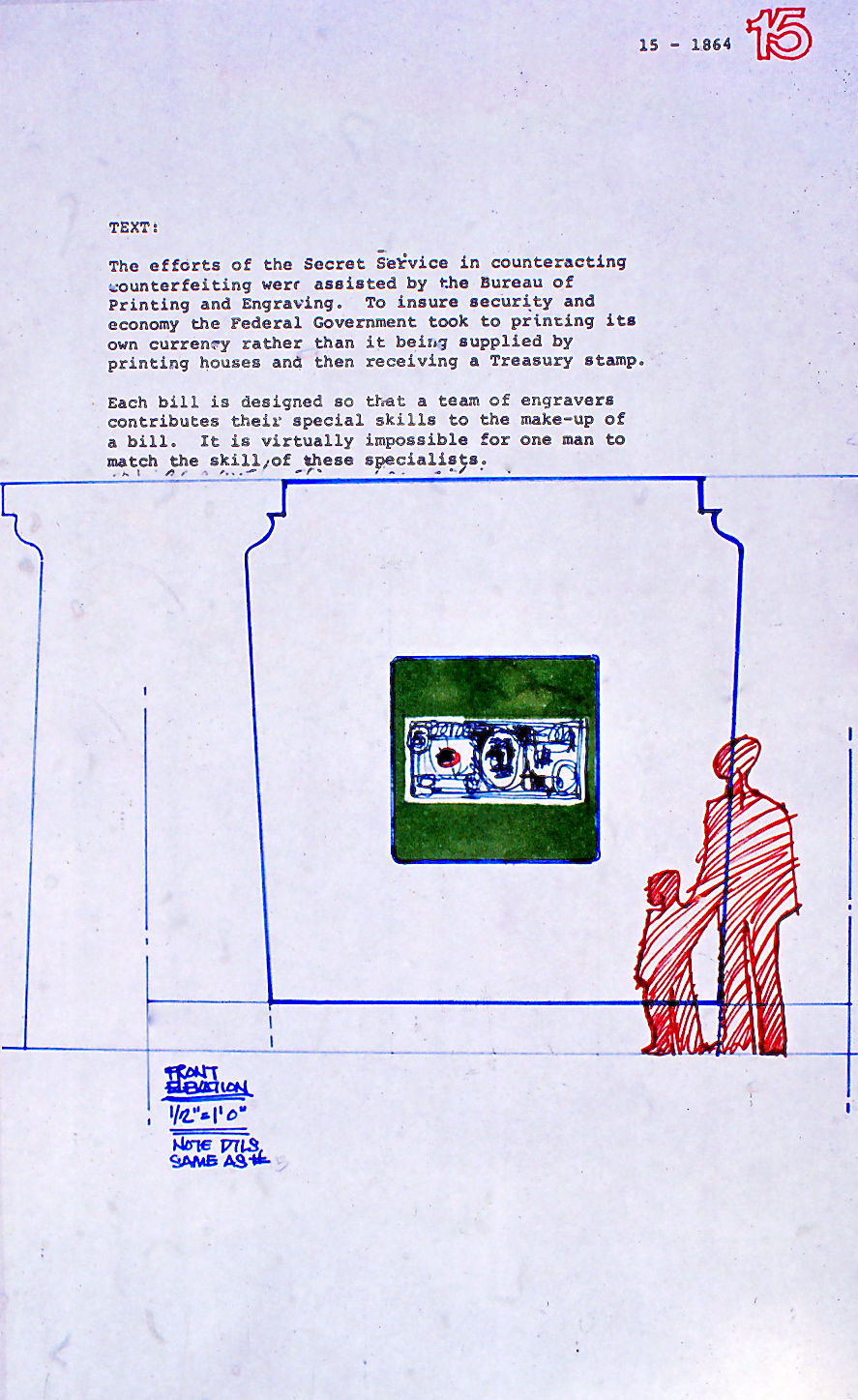
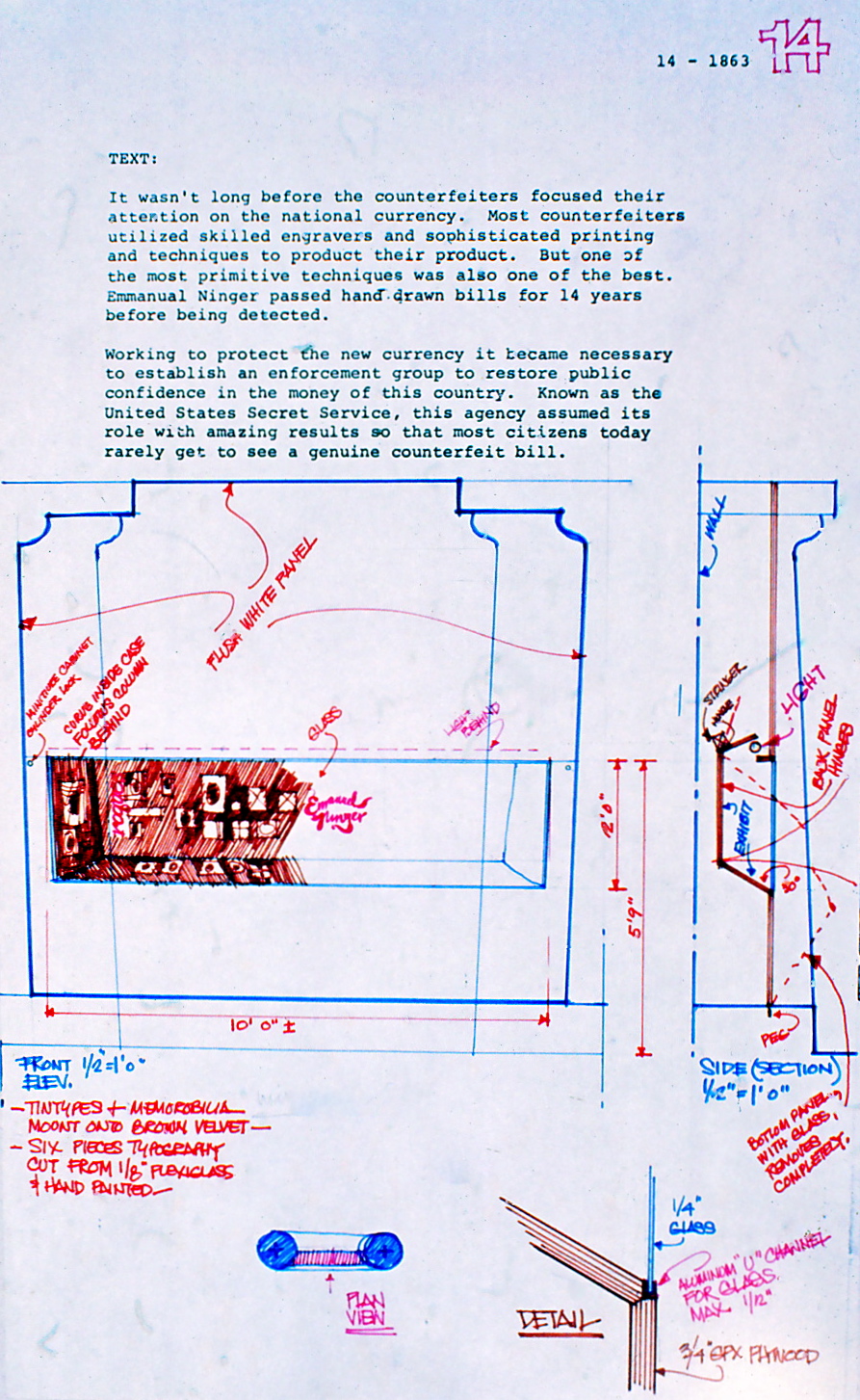
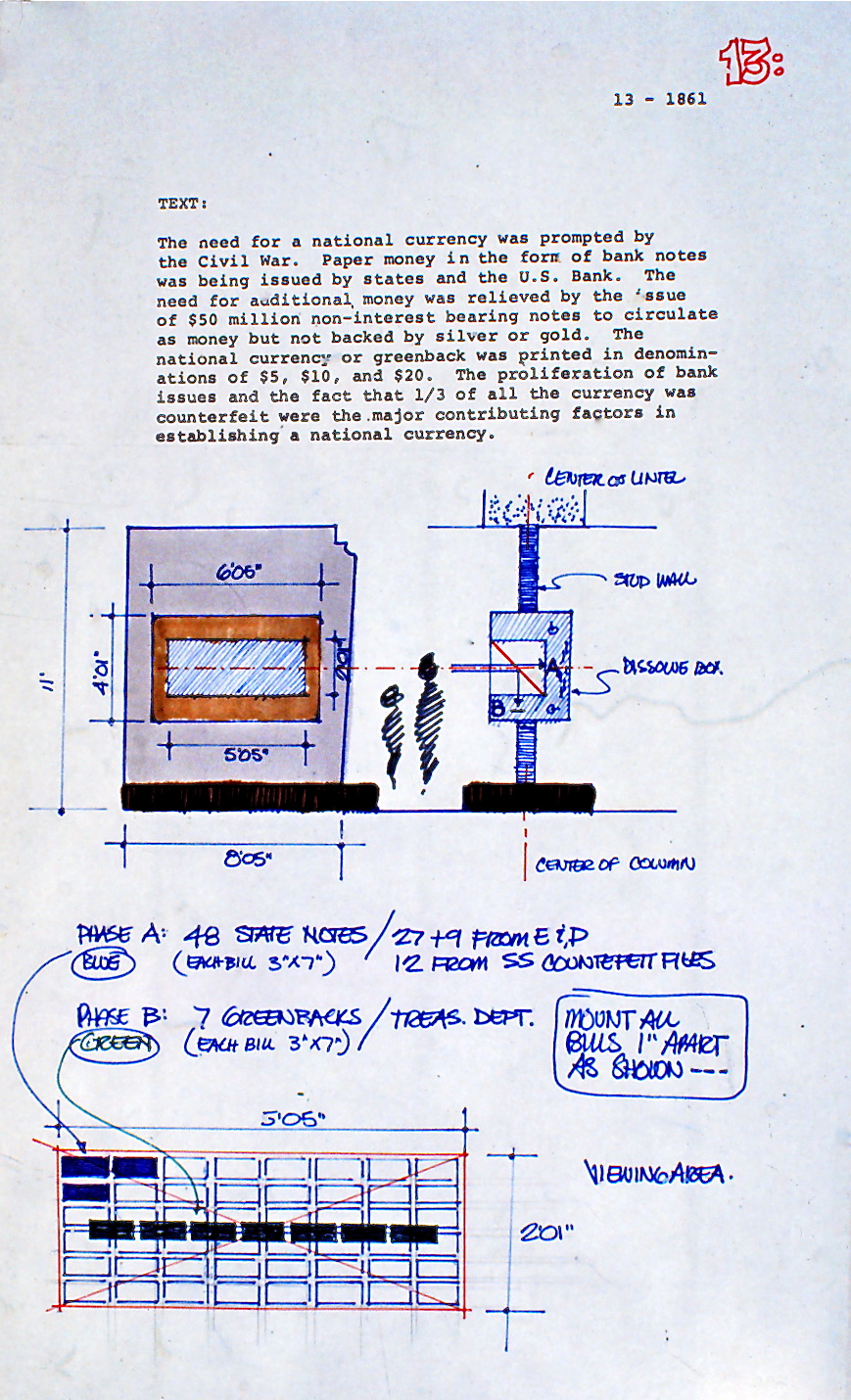
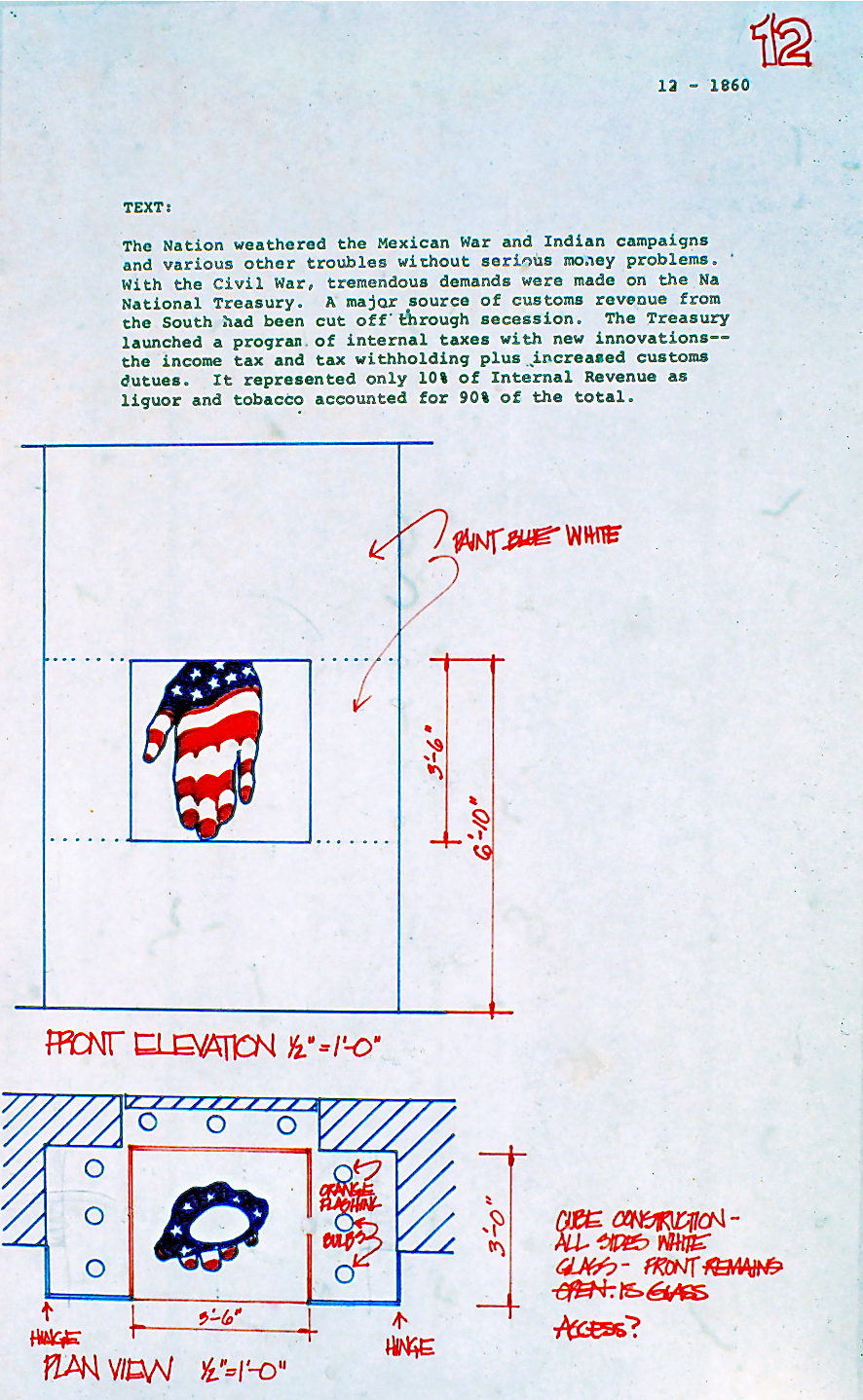

Sketches 1 to 10
Illustrated below are three examples illustrating the relationship between the original sketches and the actual on-site installations.
Sketches 11 to 19



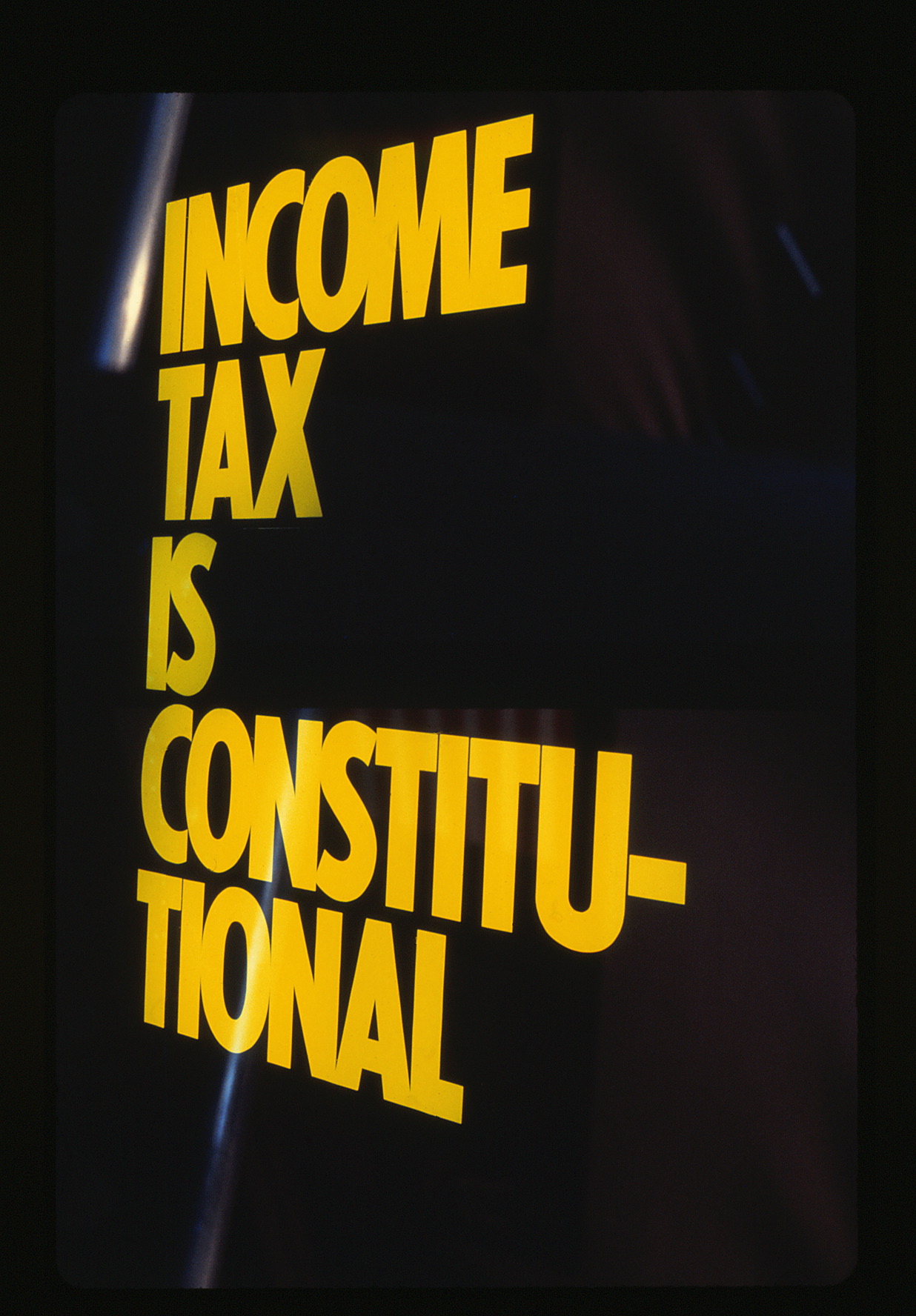

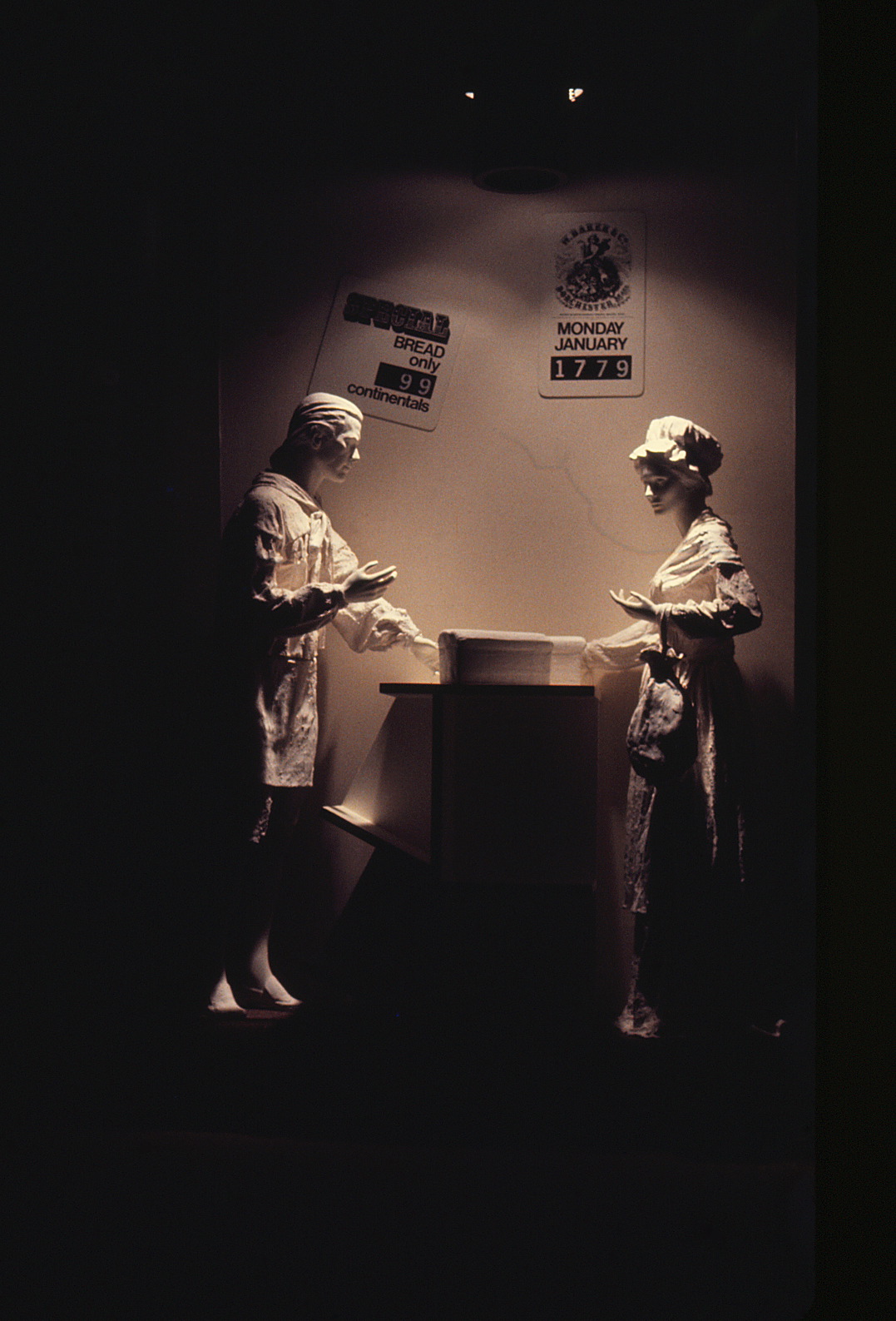
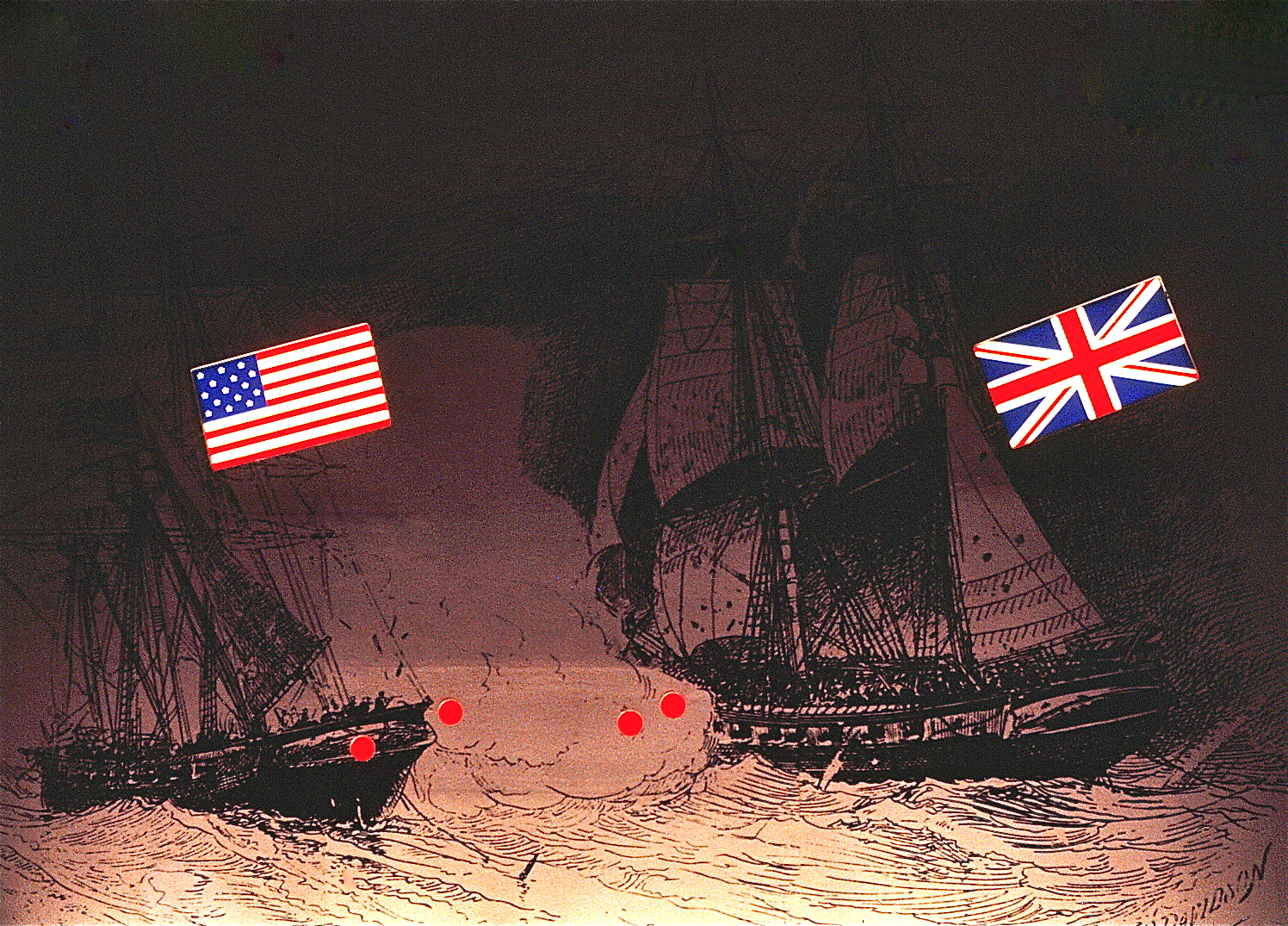
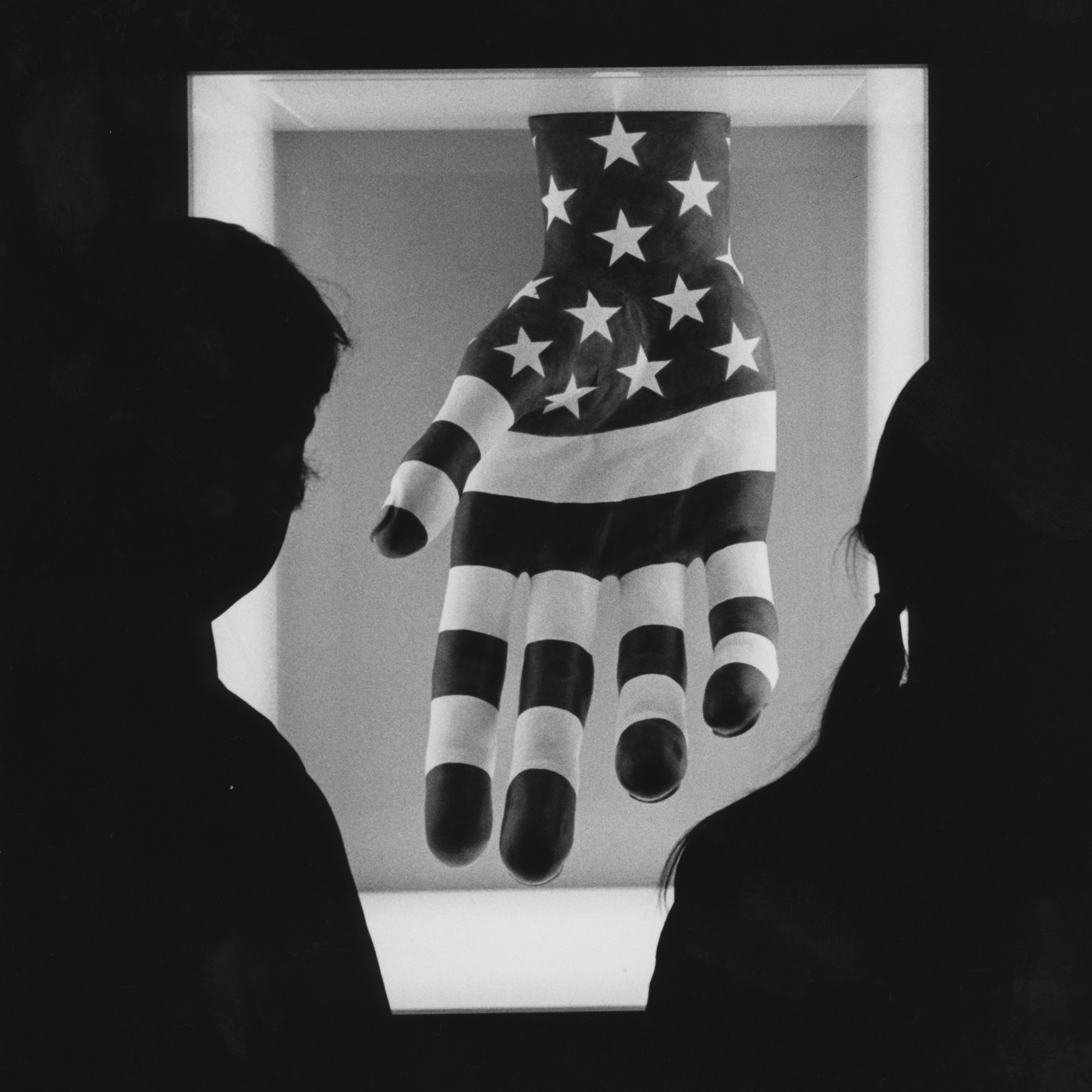
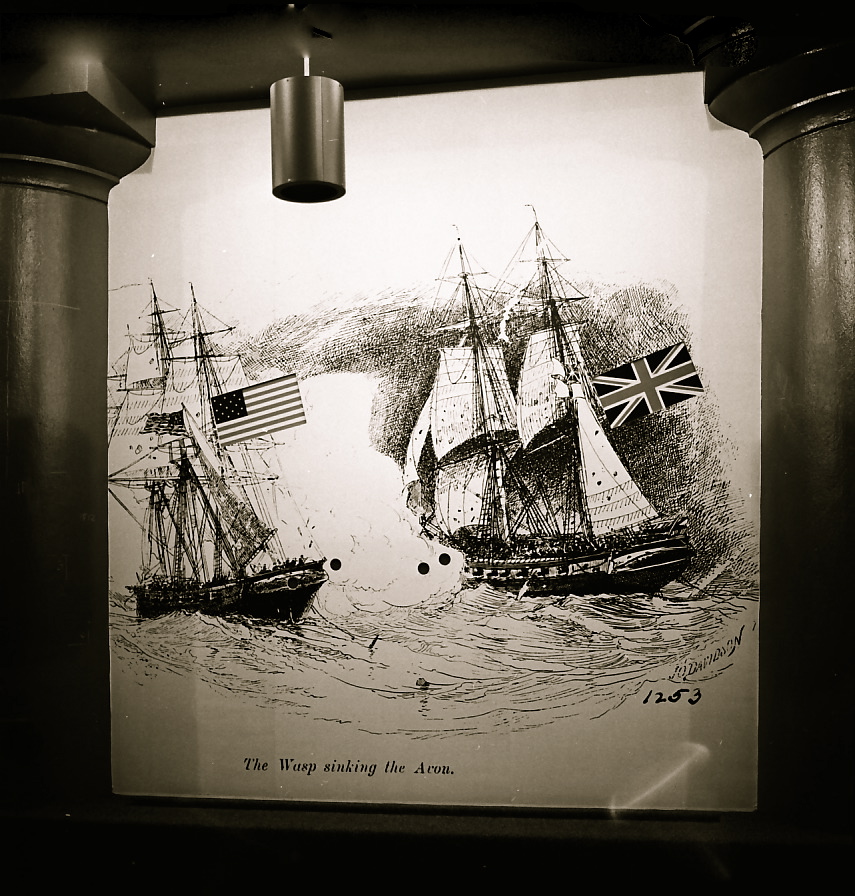
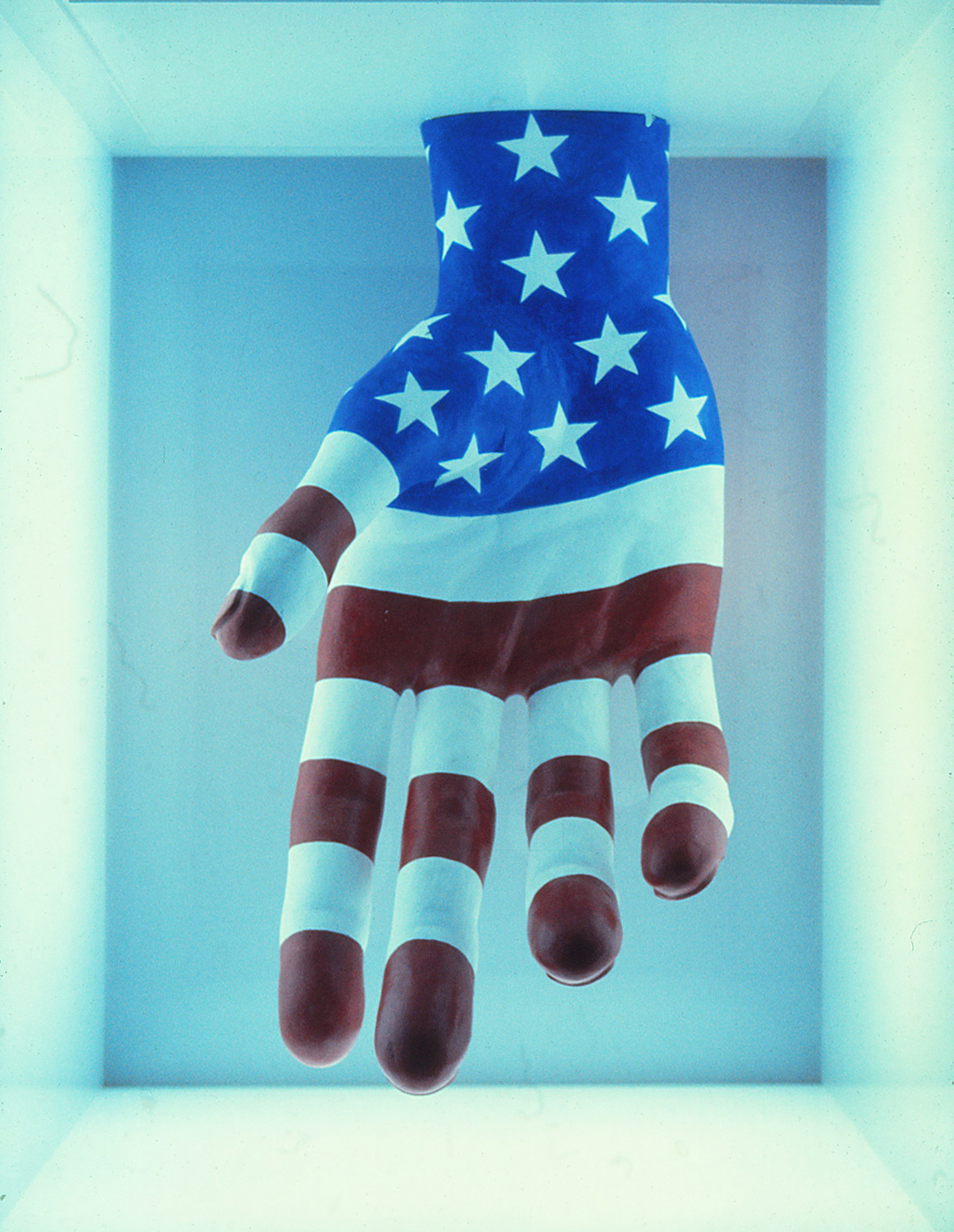
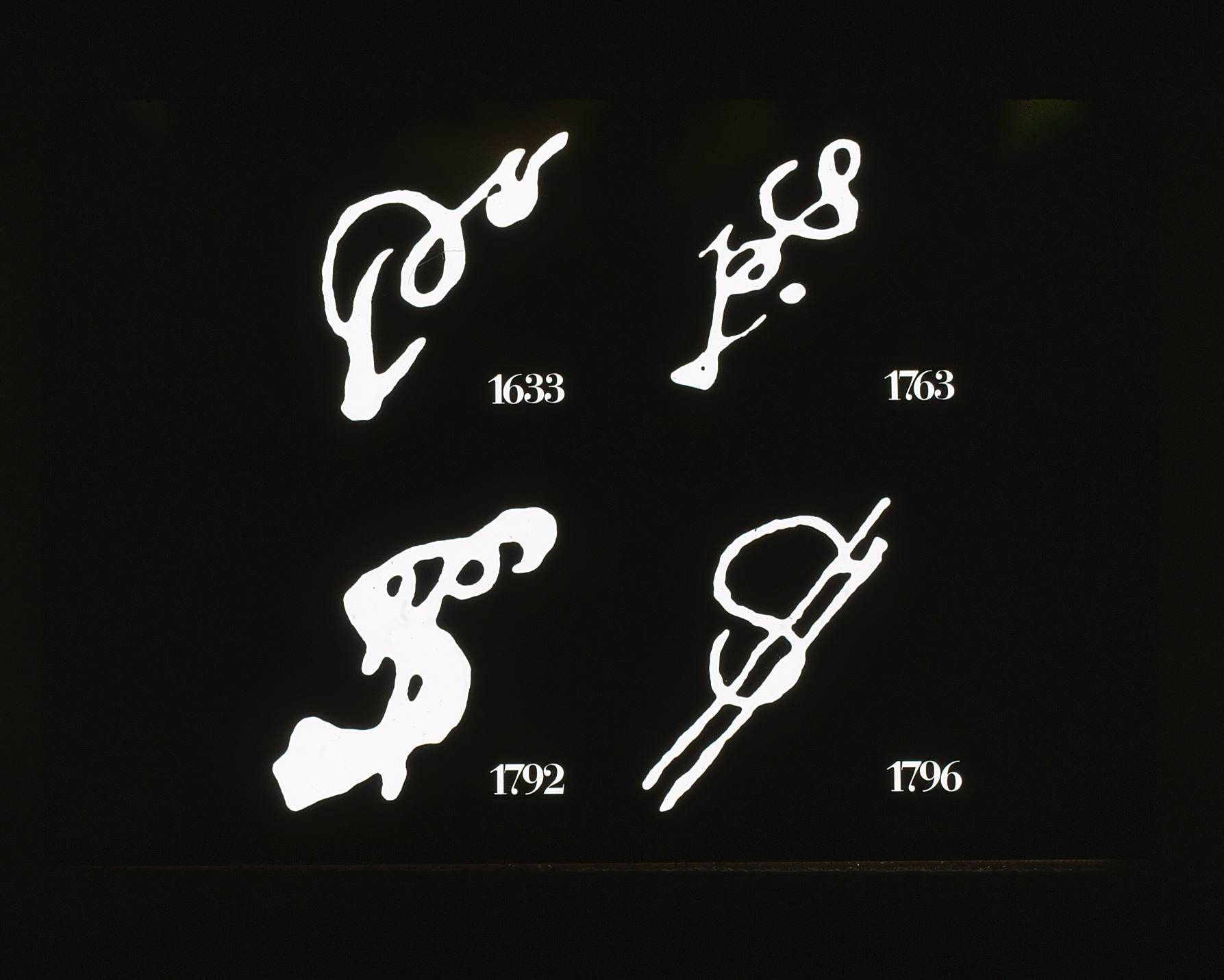
OUTLINE OF US TREASURY HISTORY
The exhibit’s timed sequence of 19 individual presentations traced the chronological history of the
US Treasury Department from 1774 thru 1950.
The exhibit’s timed sequence of 19 individual presentations traced the chronological history of the
US Treasury Department from 1774 thru 1950.
1774 - A need to finance the American Revolution.
1776 - Issued “Continentals” / Inflation / Counterfeiting.
1789 - Washington appoints Alexander Hamilton to establish a US Treasury.
1789 - Vow to pay debt / Bank of the U S / Levy tariffs.
1789 - Customs revenue / Transition - State to Federal.
1790 - Revenue Cutters / Curb smuggling / Evasion of fees / Evolved into US Coast Guard.
1792 - Colonial Peso symbol evolves into the
US Dollar sign.
1792 - Establish U S Mint / Gold & Silver into coins.
1800 - Treasury moves from Philadelphia to Washington.
1803 - Purchase Territory / Financed by US Stocks Bonds
1812 - War of 1812 / Taxes imposed on spirits, tobacco, snuff, sugar, tea, etc.
1860 - Civil War / Initiate Income Tax / 10% of all revenue.
1861 - National Currency / To stem 33% counterfeit bills.
1863 - Secret Service / Combat counterfeiters / E. Ninger.
1864 - Bureau of Engraving & Printing / No contractors.
1874 - Drug enforcement / 1 in 400 addicted / Immigrants.
1894 - Income Tax declared unconstitutional / Amended.
1916 - Financing War / War Bonds, Liberty Bonds, Savings Bonds / Stamps / Posters.
1940 - Tax revenues / 700% increase from 1940 to 1950.
1776 - Issued “Continentals” / Inflation / Counterfeiting.
1789 - Washington appoints Alexander Hamilton to establish a US Treasury.
1789 - Vow to pay debt / Bank of the U S / Levy tariffs.
1789 - Customs revenue / Transition - State to Federal.
1790 - Revenue Cutters / Curb smuggling / Evasion of fees / Evolved into US Coast Guard.
1792 - Colonial Peso symbol evolves into the
US Dollar sign.
1792 - Establish U S Mint / Gold & Silver into coins.
1800 - Treasury moves from Philadelphia to Washington.
1803 - Purchase Territory / Financed by US Stocks Bonds
1812 - War of 1812 / Taxes imposed on spirits, tobacco, snuff, sugar, tea, etc.
1860 - Civil War / Initiate Income Tax / 10% of all revenue.
1861 - National Currency / To stem 33% counterfeit bills.
1863 - Secret Service / Combat counterfeiters / E. Ninger.
1864 - Bureau of Engraving & Printing / No contractors.
1874 - Drug enforcement / 1 in 400 addicted / Immigrants.
1894 - Income Tax declared unconstitutional / Amended.
1916 - Financing War / War Bonds, Liberty Bonds, Savings Bonds / Stamps / Posters.
1940 - Tax revenues / 700% increase from 1940 to 1950.
Animated gunfire image between the USS Wasp
and the sinking of the HMS Avon, War of 1812.
Below, the on-site installation
and the sinking of the HMS Avon, War of 1812.
Below, the on-site installation
A sculptural representation symbolizing the
Treasury’s launching of internal taxes
and increased customs duties.
Treasury’s launching of internal taxes
and increased customs duties.
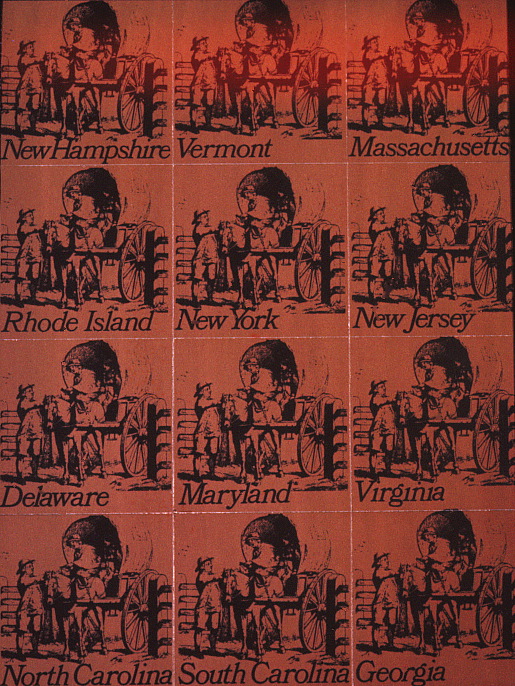


This 4 phase dissolve presentation traced
the development of the Peso sign as it
evolved into the US Dollar sign.
the development of the Peso sign as it
evolved into the US Dollar sign.
A lap-dissolve sequence illustrated in individual
layers, the progression of information, symbols,
text and colors on the typical “Greenback.”
layers, the progression of information, symbols,
text and colors on the typical “Greenback.”
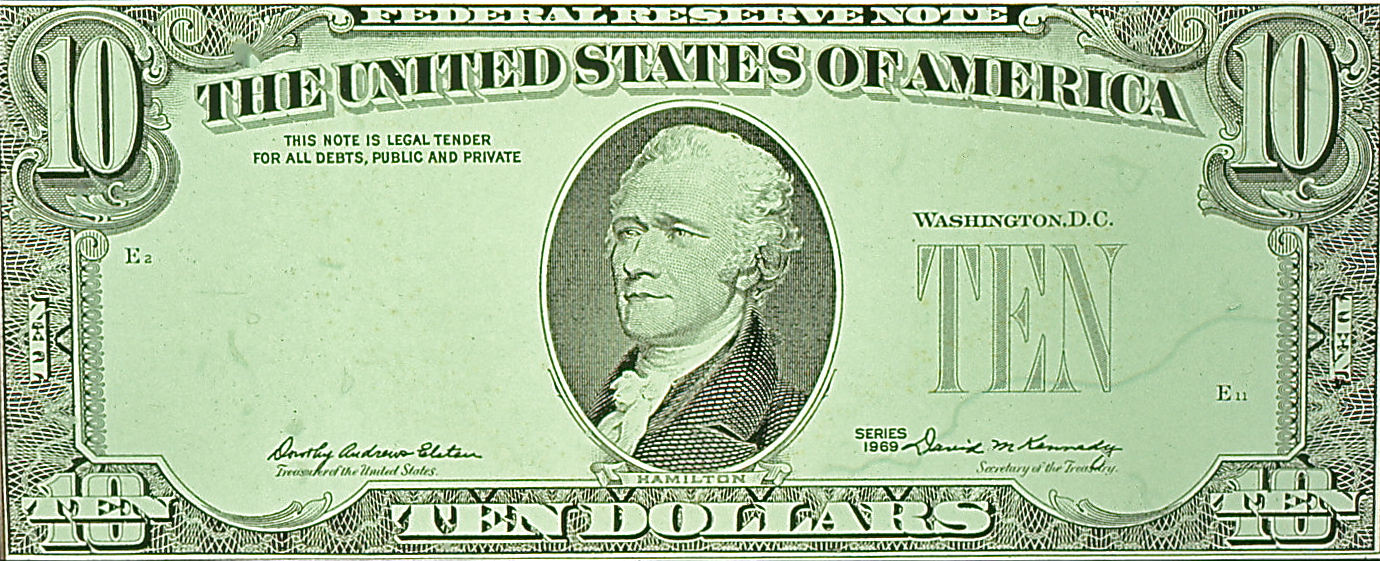
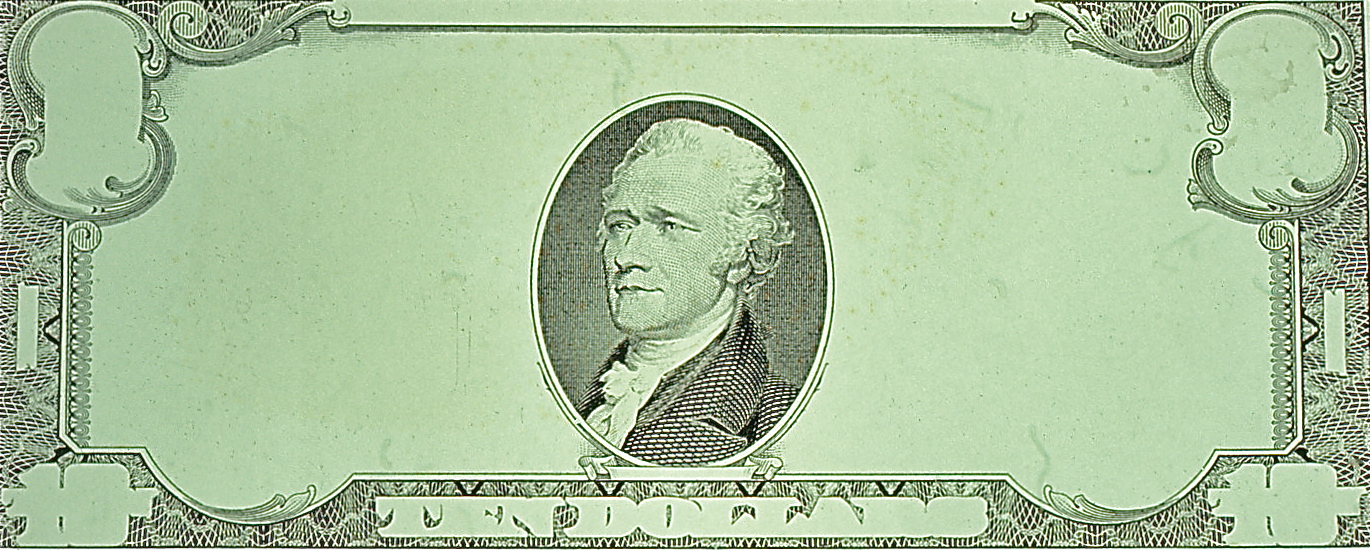
This 5 stage dissolve sequence illustrated the change from individual State Customs duties to
Federal control. This complex system of State to State duties was abolished and power given to the
Federal Government to collect all tariffs exclusively.
Federal control. This complex system of State to State duties was abolished and power given to the
Federal Government to collect all tariffs exclusively.
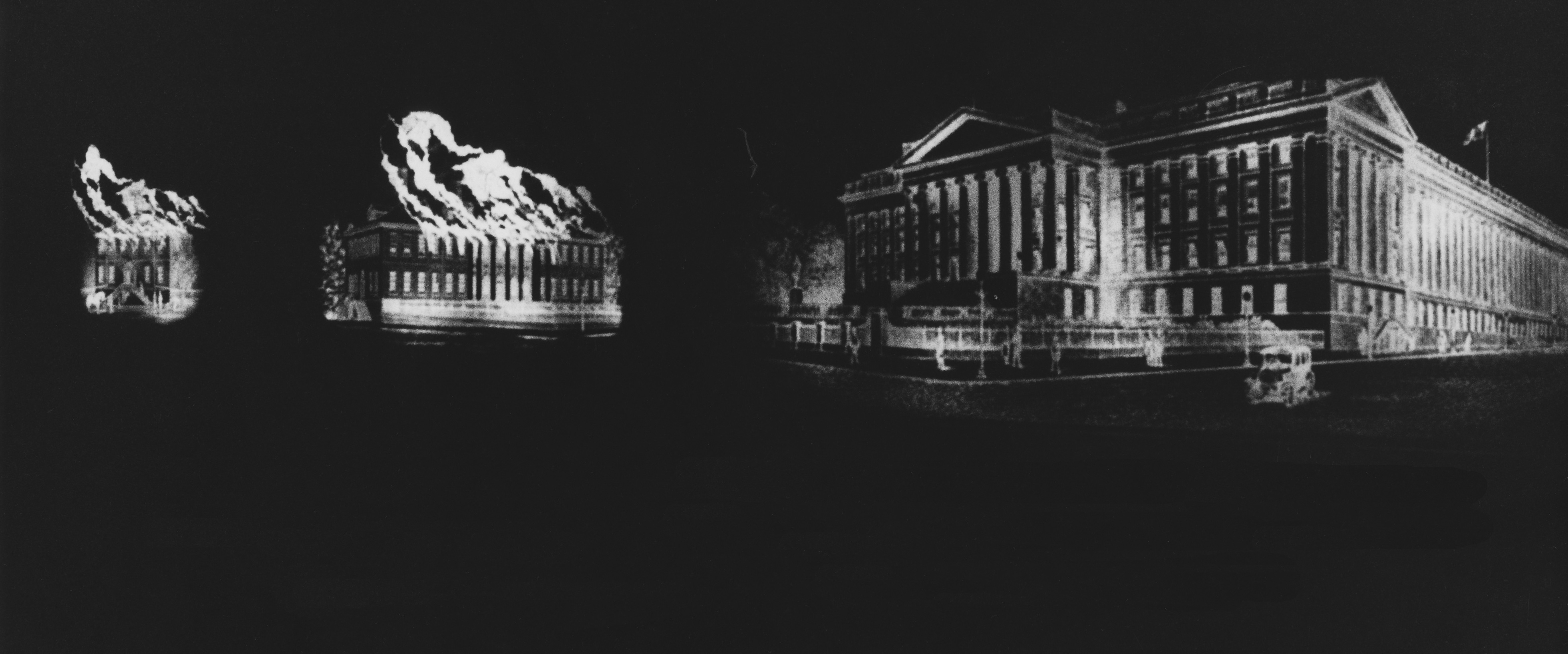
This phased dissolve display illustrates the destruction the original Treasury
building in Philadelphia and it’s successor. This led to a demand for
a “fire proof” structure to be located in Washington.
building in Philadelphia and it’s successor. This led to a demand for
a “fire proof” structure to be located in Washington.
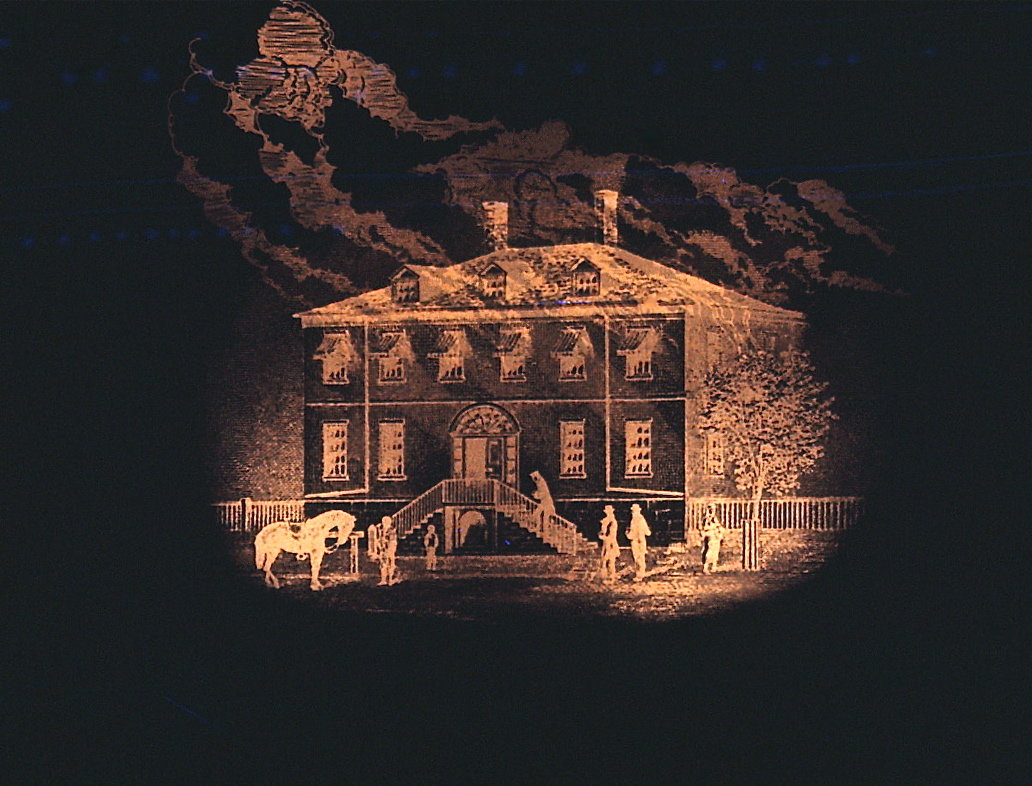
Engraving of the original Treasury Building
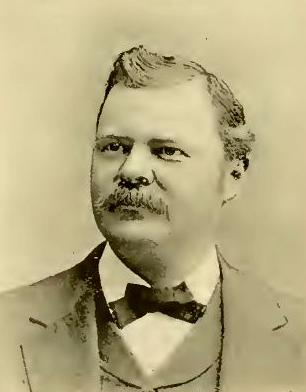
Emanuel Ninger
Also known as “Jim the
Penman,” he lived on a
farm in New Jersey.
Also known as “Jim the
Penman,” he lived on a
farm in New Jersey.
ORIGINAL
FAKE
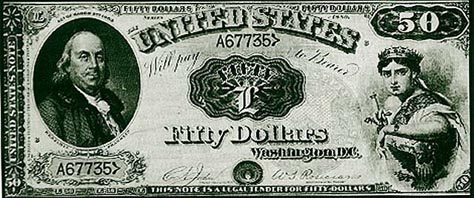
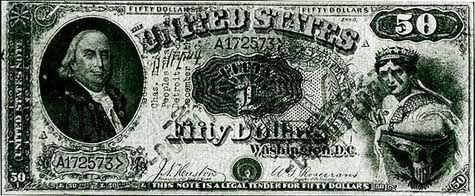
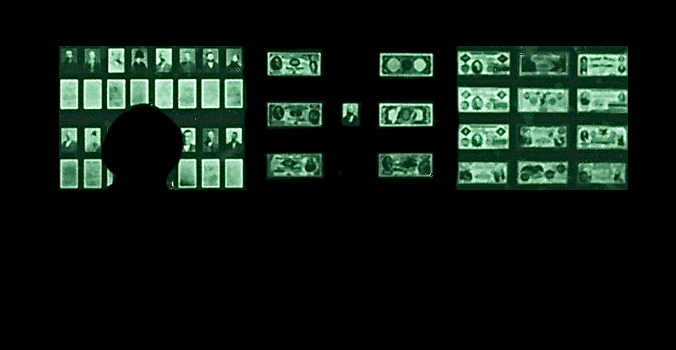
The popular Ninger exhibit displayed a rogues gallery of the most proficient counterfeiters using a variety of techniques. However, he was the only one to have any success with hand drawn bills.
THE COUNTERFEITERS
The early U S currency was susceptible to counterfeiting. With the advent of a national currency and the creation of the Bureau of Engraving & Printing, the tide turned. At one time 33% of all bills in circulation were counterfeit. Emanuel Ninger, one of the most successful counterfeiters was apprehended when one of his bills “leaked” when placed on a bar in New York City. Eventually, his $50 notes become collector items. Each of his 700 bills took
about a week to produce.
about a week to produce.

WAR BONDS

A new method of financing wars was deployed when the Treasury promoted individual participation through War Savings Stamps, Liberty Bonds and War Bonds. A series of sequentially illuminated vintage posters led the visitors to the final display
of the tenfold increase in taxes.
of the tenfold increase in taxes.


Excerpt from George Nelson’s letter to Edward. W,. Brooks,
Chief, U S Treasury, Property Management Division:
Chief, U S Treasury, Property Management Division:
“I was particularly impressed by the lighting and sound
sequences, for while we had often thought about such a
system, this was the first time we had gotten a chance to
put it into practice. The lighting works very well in
guiding the visitor and it does this without directional
signs or any suggestion of compulsion, while the narration
allows the viewer to concentrate entirely on the exhibit,
without the usual interruption for reading printed material.”
September 25, 1970.
sequences, for while we had often thought about such a
system, this was the first time we had gotten a chance to
put it into practice. The lighting works very well in
guiding the visitor and it does this without directional
signs or any suggestion of compulsion, while the narration
allows the viewer to concentrate entirely on the exhibit,
without the usual interruption for reading printed material.”
September 25, 1970.
Design: George Nelson & Company: Bill Cannan - George Nelson - Irving Harper - Dennis Stockman
Client: U S Treasury Department: Property Management Division - Edward W. Brooks, Manager
Consultants: Smithsonian Exhibit Division: Technical Team - Ron Chedister / Narration: Lloyd Moss, WQXR
Photo Credits: US Treasury Department: Treasury symbol - Treasury building - Posters
contact: Bill Cannan / 4bcnco@gmail.com
Client: U S Treasury Department: Property Management Division - Edward W. Brooks, Manager
Consultants: Smithsonian Exhibit Division: Technical Team - Ron Chedister / Narration: Lloyd Moss, WQXR
Photo Credits: US Treasury Department: Treasury symbol - Treasury building - Posters
contact: Bill Cannan / 4bcnco@gmail.com